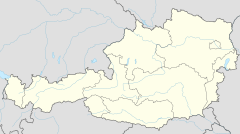Nonnberg Abbey (German: Stift Nonnberg) is a Benedictine monastery in Salzburg, Austria.[1] Founded c. 712/715 by Saint Rupert of Salzburg, it is the oldest continuously existing nunnery in the German-speaking world. The monastery complex is today a protected monument and part of the Historic Centre of the City of Salzburg, a UNESCO World Heritage Site since 1996.[2]
| Nonnberg Abbey | |
|---|---|
 Nonnberg Abbey, view from Kapuzinerberg | |
| Religion | |
| Affiliation | Catholic Church |
| Ecclesiastical or organizational status | Active |
| Year consecrated | 714 |
| Status | Convent |
| Location | |
| Location | Salzburg, Austria |
| State | Salzburg |
| Sector | St. John's Chapel |
| Geographic coordinates | 47°47′46″N 13°03′06″E / 47.79611°N 13.05167°E |
| Architecture | |
| Type | Monastery |
| Style | Romanesque, Gothic |
| Founder | Saint Rupert of Salzburg |
History
editIn the early eighth century, Rupert of Salzburg established the monastery beneath the Festungsberg hill and the ruined fortifications of the former Roman city of Juvavum. Its first abbess was Saint Erentrudis of Salzburg, who was either a niece or a sister of Bishop Rupert. Since 1624 she has held the title of "Landesmutter Salzburgs" (Mother of Salzburg) and her tomb is in the crypt of the church.[3]
The abbey's endowment was provided by the Agilolfing duke Theodo of Bavaria and his successor Theodbert. The abbey became independent of the founding house from 987. The nuns, all of noble birth, held extended estates up the Salzach river in the south of the city. The obligation of nobility for the nuns – a prerequisite for admission to the convent – which had existed since the Middle Ages, was abolished in 1848. The convent's possessions were later augmented by Emperor Henry II, who was also Duke of Bavaria.
After a blaze about 1006, the abbey church was re-built with the support of Henry II; he and his consort Cunigunde of Luxembourg attended the consecration in 1009. This Romanesque building was again largely destroyed in a fire of 1423. Reconstruction took place between 1464 and 1509. In 1624 the church was enlarged by the addition of three side chapels. A refurbishment in the Baroque style took place in the 1880s.
The Benedictine rule was implemented under Archbishop Conrad I of Salzburg in the early 12th century. The late Gothic winged altar with the statue of Mary is the centrepiece of the abbey church.[4]
Present day
editThe nuns sing Gregorian Chorals every morning, however from mid-September (until around Easter 2024), due to the renovation of the choir chapel, it will not be possible to listen in during Holy Mass or prayer times. However, the church will be open without restriction.[4]
About 195 manuscripts dating from the 14th to the 18th c. have been copied to film by the Hill Museum and Manuscript Library.[5]
Commemorative coin
editHohensalzburg Fortress | |||||||||||||||||||||||||||||||||||||||||||||||||
|---|---|---|---|---|---|---|---|---|---|---|---|---|---|---|---|---|---|---|---|---|---|---|---|---|---|---|---|---|---|---|---|---|---|---|---|---|---|---|---|---|---|---|---|---|---|---|---|---|---|
| |||||||||||||||||||||||||||||||||||||||||||||||||
The Abbey was selected as main motif for the Austrian Nonnberg Abbey commemorative coin minted on April 5, 2006. This was the first coin of the series "Great Abbeys of Austria". It shows the Benedictine convent of Nonnberg Abbey. On the hilltop in the background, Hohensalzburg Fortress and the Kajetaner church can be seen. The abbey and fortress are connected by the Reisszug, one of the world's oldest extant railways.
In popular culture
editAt Nonnberg the story of Maria von Trapp began, who became a postulant there in 1924 and whose life was the basis for the Broadway musical (1959) and (1965) film, The Sound of Music.[4] The abbess during Maria's time at Nonnberg was Virgilia Lütz (1869-1949). Some scenes from the movie were filmed at the abbey.[6]
Gallery
edit-
Euro gold and silver commemorative coin
-
The wooden Gothic altar in the St. John's Chapel by the sculptor Veit Stoss
-
Pillars inside the St. John's Chapel in Nonnberg Abbey
-
The entrance door to the St. John's Chapel in Nonnberg Abbey which is open to the public
-
The road to the gate of Nonnberg Abbey
-
The entrance gate of the Nonnberg Abbey which is open to the public
-
Interior
References
edit- Citations
- ^ Smith, Christine; Cyrus, Cynthia J. "Nonnberg Abbey". Monastic Matrix. Retrieved 4 February 2013.
- ^ "Nonnberg Abbey", Religiana
- ^ Butler, Alban (1981). (vol. 2). Westminster, Maryland: Liturgical Press, p. 678 ISBN 0814623778. OCLC 33824974
- ^ a b c "Nonnberg Abbey", Tourismus Salzburg GmbH
- ^ "Nonnberg (Abbey). Stiftsbibliothek", HMML
- ^ Hirsch, Julia Antopol. The Sound of Music: The Making of America's Favorite Movie. Chicago: Contemporary Books, 1993, ISBN 9780809238378
- Bibliography
- Franz Esterl: Chronik des adeligen Benediktiner-Frauen-Stiftes Nonnberg in Salzburg, Salzburg, 1841 (at Google Books, in German)
External links
edit- www.nonnberg.at Official Website
- Nonnberg Abbey at Sacred Destinations
- Stift Nonnberg at Visit-Salzburg
- Historic Centre of the City of Salzburg at UNESCO
